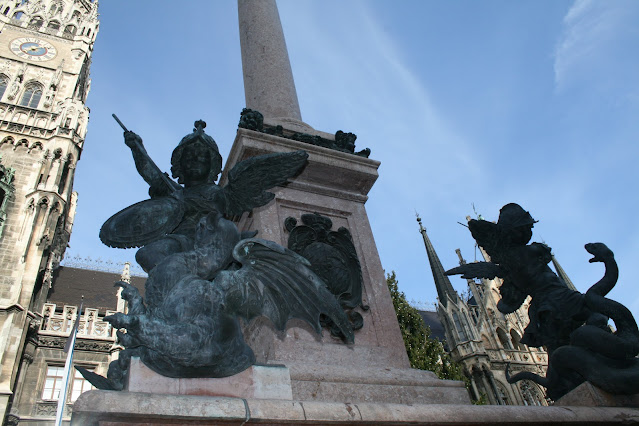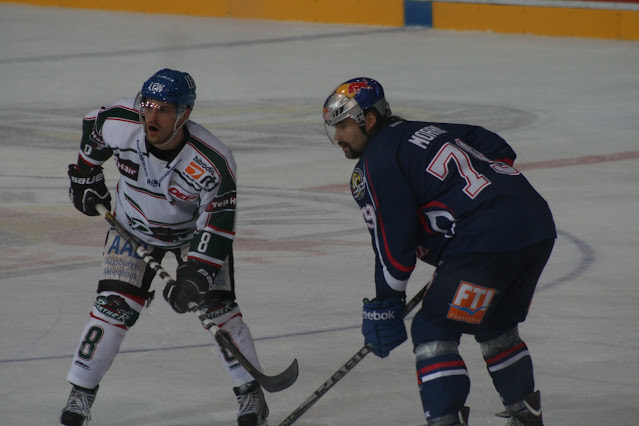Its native name, München, is derived from the Old High German Munichen, meaning "by the monks' place" and this is due to the fact that the town was originally situated near a monastery of the Benedictine monks.
The city has a rich history being the capital of Bavaria, and is well known for its beer!
For example the church built in the centre of the city (Frauenkirche) has an interesting history wherein the architect made a deal with the devil to have it completed within 20 years.
The church was built by Jörg “Ganghofer” Halspach in the then record time of 20 years (1468-1488) and the towers were added 30 years later.
The story goes that the devil agreed to finance the church, provided Halspach built it without windows running down the aisles. When the work was done Halspach led the Devil to a point near the entrance where none of the side windows could be seen – the view was blocked by 22 inner columns.
The Devil threw a tantrum and stamped his foot real hard, leaving a mark that remains to this day. There always seems to be a wind blowing around the church and that’s said to be Satan himself, circling around looking for the side windows.
Here is the devils footprint!
We also learned some fascinating things about the world famous beer hall Hofbrauhaus am Platzl.
Wilhelm V., Duke of Bavaria really loved beer, and he was not happy enough with the locally brewed beers, so he would import from the city of Einbeck in Lower Saxony.
Wilhelm then asked his royal court to come up with a way to reduce these outgoing costs and so on September 27 1589, his advisors recommended they build a brewery of their own.
So they hired the master brewer of the Geisenfeld Monastery, to assist with planning the new brewery and to devise a recipe for a "brown" beer. The brewery started in the “Alter Hof” ( Old Court ) in 1592.
It was called the “brown” Hofbräuhaus as only brown ale was brewed there.
Wilhelm’s son and successor, Duke Maximilian I., preferred wheat beers and to secure the Hobräuhaus as the best in Munich he banned any other private brewery from producing wheat beers.
This caused so much demand for wheat beer that he moved the Hobräuhaus to Platzl, where it became known as the "white" Hobräuhaus due to its new specialty in wheat beers.
An interesting side note to this is that during the Thirty Year War, the Swedish army arrived in Munich, and rather than simply destroying it and moving on as they usually did, they decided to stay since they loved the city so much.
Duke Maximilian I. had fled with his own army before the Swedish army had arrived, and so the citizens of Munich had to tolerate these invaders living amongst them.
After some time they asked if there was some way to pay the Swedes to leave, it was decided that 300,000 gold pieces would suffice.
The citizens tried their hardest and raised 180,000 gold pieces, however that was still not enough, so they made a deal to pay the remainder with the beautiful wheat beer of which they had an abundance.
And so the Swedish army took the beer and left... the citizens decided to throw a party in Marienplatz square, when Maximilian arrived to participate they were naturally a little upset.
So he told them that he had gone to the alps to find a high place to pray to Mother Mary for protection from the Swedish Army and to deliver their city.
The citizens being quite gullible believed this, and it was decided a statue should be erected for Maximilian, however he declared that it should instead be a statue of Mary.
This is how the "Mariensäule" was built in 1638, and is also the reason "Schrannenmarkt" was renamed to "Marienplatz" in 1853.
But back to the Hofbräuhaus! In 1828 the now reigning King Ludwig I. made a proclamation that the Hofbräuhaus be opened to the general public (women were excluded) rather than simply court officials and other dignitaries.
And this is how the Hofbräuhaus has continued to this day (only now women are also allowed!)
In 1844 not to be outdone by his previous generosity King Ludwig I. declared that beer should be sold at a fixed price, so that the working class and military could also afford a drink.
Enough about beer!
What about a castle?
On a nice Saturday, we hired a car, and drove through some beautiful countryside to a town called Hohenschwangau where there are two amazing castles.
The first and most famous is Neuschwanstein, which looks like something from a Disney movie (and is actually the basis for the castle in Cinderella) this castle was built by King Ludwig II. of Bavaria and was a tribute to composer Richard Wagner as well as a private retreat for the King himself.
The second is Hohenschwangau, which was rebuilt from ruins by King Ludwig II's father King Maximilian.
Unfortunately we didn't have time for the tours, but here are some pictures, and I have included links to the respective articles below.
What about a local past time?
ICE HOCKEY! Everyone knows I am not a huge sports person, but since I had played field hockey when I was younger I figured I could make an exception to see an ice hockey game.
It was actually really fun, we drank, we cheered, and had an exceptional time. The game was Munich vs Augsburg, the final score was 5-0 to Munich.
Since this post is already very long, I will stop...
NEXT TIME! Berlin for a Garbage concert and sightseeing, London for Christmas, and Scotland for New Years!
References:
http://en.wikipedia.org/wiki/Munich_Frauenkirche - Frauenkirche
http://en.wikipedia.org/wiki/Eishockeyclub_M%C3%BCnchen – Munich Ice Hockey Team
http://en.wikipedia.org/wiki/Hofbr%C3%A4uhaus_am_Platzl – Hofbrauhaus am Platzl
http://en.wikipedia.org/wiki/Neuschwanstein_Castle - Castle Neuschwanstein
http://en.wikipedia.org/wiki/Hohenschwangau_Castle - Castle Hohenschwangau
http://en.wikipedia.org/wiki/Hohenschwangau - The town the castles are in
http://www.newmunichtours.com/ - free city tour (our guide was Blake)
http://www.destination-munich.com/frauenkirche.html - Destination Munich entry on Frauenkirche
http://www.hofbraeuhaus.de/en/01/hist_anfang_en.html - History of the Hofbrauhaus
http://www.neuschwanstein.de/englisch/palace/index.htm - Castle Neuschwanstein
The Devil threw a tantrum and stamped his foot real hard, leaving a mark that remains to this day. There always seems to be a wind blowing around the church and that’s said to be Satan himself, circling around looking for the side windows.
Here is the devils footprint!
Wilhelm V., Duke of Bavaria really loved beer, and he was not happy enough with the locally brewed beers, so he would import from the city of Einbeck in Lower Saxony.
Wilhelm then asked his royal court to come up with a way to reduce these outgoing costs and so on September 27 1589, his advisors recommended they build a brewery of their own.
So they hired the master brewer of the Geisenfeld Monastery, to assist with planning the new brewery and to devise a recipe for a "brown" beer. The brewery started in the “Alter Hof” ( Old Court ) in 1592.
It was called the “brown” Hofbräuhaus as only brown ale was brewed there.
Wilhelm’s son and successor, Duke Maximilian I., preferred wheat beers and to secure the Hobräuhaus as the best in Munich he banned any other private brewery from producing wheat beers.
This caused so much demand for wheat beer that he moved the Hobräuhaus to Platzl, where it became known as the "white" Hobräuhaus due to its new specialty in wheat beers.
Duke Maximilian I. had fled with his own army before the Swedish army had arrived, and so the citizens of Munich had to tolerate these invaders living amongst them.
After some time they asked if there was some way to pay the Swedes to leave, it was decided that 300,000 gold pieces would suffice.
The citizens tried their hardest and raised 180,000 gold pieces, however that was still not enough, so they made a deal to pay the remainder with the beautiful wheat beer of which they had an abundance.
And so the Swedish army took the beer and left... the citizens decided to throw a party in Marienplatz square, when Maximilian arrived to participate they were naturally a little upset.
So he told them that he had gone to the alps to find a high place to pray to Mother Mary for protection from the Swedish Army and to deliver their city.
The citizens being quite gullible believed this, and it was decided a statue should be erected for Maximilian, however he declared that it should instead be a statue of Mary.
This is how the "Mariensäule" was built in 1638, and is also the reason "Schrannenmarkt" was renamed to "Marienplatz" in 1853.
And this is how the Hofbräuhaus has continued to this day (only now women are also allowed!)
In 1844 not to be outdone by his previous generosity King Ludwig I. declared that beer should be sold at a fixed price, so that the working class and military could also afford a drink.
What about a castle?
On a nice Saturday, we hired a car, and drove through some beautiful countryside to a town called Hohenschwangau where there are two amazing castles.
Unfortunately we didn't have time for the tours, but here are some pictures, and I have included links to the respective articles below.
What about a local past time?
ICE HOCKEY! Everyone knows I am not a huge sports person, but since I had played field hockey when I was younger I figured I could make an exception to see an ice hockey game.
It was actually really fun, we drank, we cheered, and had an exceptional time. The game was Munich vs Augsburg, the final score was 5-0 to Munich.
NEXT TIME! Berlin for a Garbage concert and sightseeing, London for Christmas, and Scotland for New Years!
References:
http://en.wikipedia.org/wiki/Munich_Frauenkirche - Frauenkirche
http://en.wikipedia.org/wiki/Eishockeyclub_M%C3%BCnchen – Munich Ice Hockey Team
http://en.wikipedia.org/wiki/Hofbr%C3%A4uhaus_am_Platzl – Hofbrauhaus am Platzl
http://en.wikipedia.org/wiki/Neuschwanstein_Castle - Castle Neuschwanstein
http://en.wikipedia.org/wiki/Hohenschwangau_Castle - Castle Hohenschwangau
http://en.wikipedia.org/wiki/Hohenschwangau - The town the castles are in
http://www.newmunichtours.com/ - free city tour (our guide was Blake)
http://www.destination-munich.com/frauenkirche.html - Destination Munich entry on Frauenkirche
http://www.hofbraeuhaus.de/en/01/hist_anfang_en.html - History of the Hofbrauhaus
http://www.neuschwanstein.de/englisch/palace/index.htm - Castle Neuschwanstein























No comments:
Post a Comment